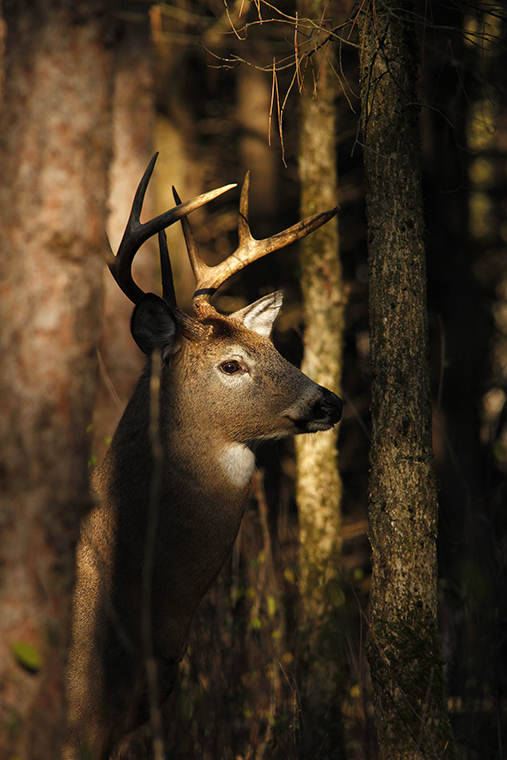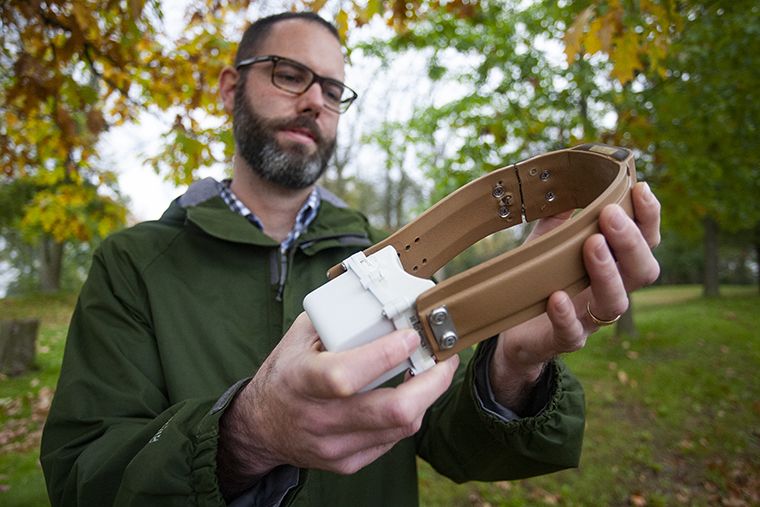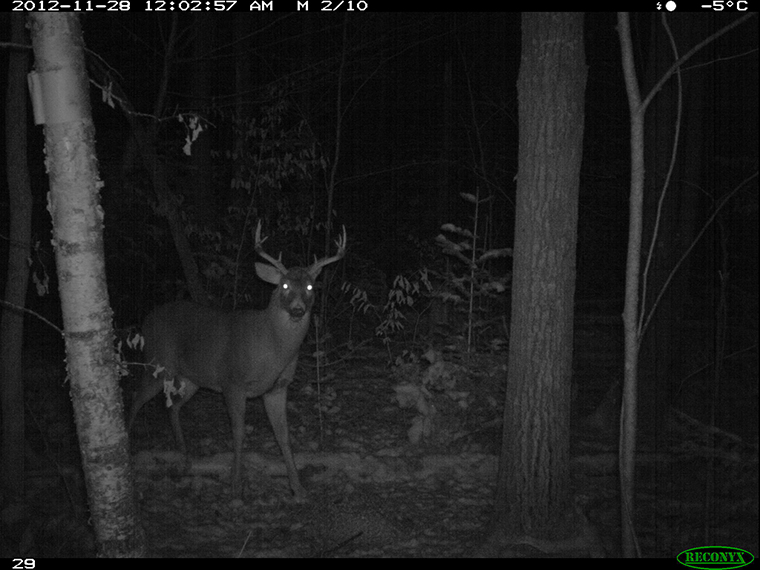
For as long as white-tailed deer populations have been managed across North America, game biologists have made management decisions predominantly based on population estimates and hunter harvests.
But one thesis accepted in 2020, authored by the Ontario Federation of Angler’s and Hunters’ (OFAH) Dr. Keith Munro, and supervised by two MNRF research scientists and funded by the ministry, examined the idea that deer management might be improved, if hunter harvest wasn’t the only metric used. After all, only a relatively small percentage of a deer population is harvested by hunters, whereas a large percentage of that same population modifies their behaviour and use of the landscape during the hunting season due to human activity.
What he was delving further into was the concept of “a landscape of fear,” a phrase Munro and other researchers have used to describe how prey species view a landscape fraught with risk and human activity.
Dr. Munro’s thesis, entitled White-Tailed Fear: The Human-Created Landscape of Fear and its Effect on White-tailed Deer (Odocoileus virginianus) Behaviour, was designed to examine if what he learned about deer behaviour in the landscape of fear could be used to manage deer more efficiently.
Munro wondered if game managers could create a landscape of fear, for example, around a highway to reduce the number of deer-automobile collisions? Or to mitigate deer-induced crop damage or even the degradation of sensitive habitats? To do so he focused on the social aspect of the hunt as well as hunter and deer behaviour during the hunting season.
Fear study
Dr. Munro interviewed and surveyed landowners in southern and eastern Ontario to determine why they allowed or limited deer hunting on their properties. He then used information from GPS tracking devices worn by deer hunters and their dogs to determine the habitat they chose to hunt. He also placed GPS tracking devices on deer to determine their habitat selection as they responded to hunting pressure. Lastly, he set up a network of trail cameras to monitor “fine-scale behaviour” of deer in areas with and without hunting.
“My idea was to examine how wildlife managers could use areas of fear to reduce wildlife conflict, but ultimately what we found was that the landscape that deer respond to and how they respond was more interesting and complex than we had initially thought.”
Whether managing deer and other game species by understanding the indirect effects of hunting created in a landscape of fear will be incorporated into the future of game management is yet to be determined. But, as it turns out, what Munro learned also benefits the hunter in the here and now.
The adaptable deer

One of the most important things he observed was how deer tailor specific responses for specific situations.
“Deer respond to the human-driven landscape of fear but do so in response to their local conditions, while displaying a high degree of behavioural flexibility and hunter-specific avoidance strategies,” he wrote.
One such response — going nocturnal — is an adaptation already noticed by hunters. Deer commonly do this during hunting season when pressured. What hunters might not have considered is that this is a behaviour used solely in response to human hunters. Which is to say, deer do not go nocturnal for natural predators. That would be useless, since predators such as the cougar or wolf do not abide by our legal hunting hours. But, as we can all attest, this response is quite effective when dealing with us.
Munro also noted that it is probable that deer react to certain types of hunting in ways comparable to predators that use the same strategies.
Fear strategies
“They likely react to tree-stand or ground-stand hunters as they would an ambush predator, such as a cougar,” he said.
Meaning they might be more prone to moving cautiously in areas where they have learned stand hunters are prevalent and spend a lot more time being vigilant in those areas.
On the other hand, he said, “They may respond to hunters who make drives or run hounds in the similar way they would respond to coursing predators such as wolves.”
This means they likely keep ahead and try to lose their pursuers, by tactics such as using water as part of an escape route, doubling back or taking to impenetrable cover.
One last avoidance strategy, Munro noted, that is specifically reserved for human hunters is taking refuge on properties where no hunting is allowed or in habitat that hunters do not disturb, perhaps due to remoteness or access effort required. Again, this would mean nothing to a natural predator, but it is quite an effective strategy against hunters.
Let’s all behave
“During the hunt, likely the biggest driver of deer behaviour is hunter behaviour,” Munro said.
How deer behaviour changes is often a direct result of hunting tactics, he added.
Munro found that hunters who use dogs have a wider and more dramatic distribution of hunting effort across the landscape. Their dogs can tirelessly cover ground that hunters can’t during the course of a hunt. And, unlike wolves and coyotes, hunting dogs are less likely concerned about energy expenditure, presumably because they know there is a meal waiting for them at the end of the day. As a result, other studies have found they give chase longer and disturb (and therefore create a landscape of fear) for longer durations, across wider swath of territory.
On the other hand, hunters who sit in stands create a very defined landscape of fear where high-risk areas begin. This is likely less pronounced for still-hunters and those groups that enact deer drives, but their activities still do not have the potential to disturb as much deer habitat as hunting dogs do.
Munro says deer, like all prey animals, must balance the cost of their predator avoidance strategies, in terms of energetic costs and missed opportunity costs of forgoing the benefits of foraging, mating, and defending territory, with the benefits of avoiding the direct effects of predation (death or severe injury).
To do so, they have developed well-documented hunter-avoidance strategies, previously mentioned, that include increased vigilance by reducing movement and selecting better cover, going nocturnal, and shifting space into areas of refuge when pressured. He sees the last part, refuge, as likely to play a larger part in deer hunting and deer management, as development of rural and exurban areas continues.
Finding refuge
One of the things Munro learned from landowner surveys and conversations is that, in southern and eastern Ontario, more than 40% of huntable rural and exurban landscape could be inaccessible to hunters due to landowner decisions and bylaws that exclude hunters.
Typically, how the landowner participated in hunting has bearing on the access given. Munro’s surveys found the likelihood of a property being hunted decreased by 98.2% if the respondent had never hunted, relative to a respondent that currently or formerly hunted deer.
If they hunted, it was more likely hunters would have access to the property, too. Deer-related property damage or automobile collisions also played a part in the decision of a landowner to grant permission to hunters or to hunt the property themselves, but this was less important than whether or not the respondent hunted.
Munro’s research indicated that the size of the parcel of land was the main physical characteristic distinguishing between hunted and non-hunted properties. Essentially, if there were two properties with the exact same landscape, the odds are statistically better to gain permission to hunt on the larger property.
How does all this affect hunters?
Munro and others have determined that properties where hunting is not allowed become refuges for white-tailed deer, especially if those properties are already a component of the animal’s annual range.
“I think it has to be learned behaviour,” he said. “We know that does teach fawns where wintering areas are. I don’t see why they wouldn’t teach them other things. Part of it is trial and error. Research has also recognized that in areas where hunting first occurs, success rates go down after the initials hunts, which indicates that deer quickly learn areas of risk. So, why wouldn’t they learn area of non-risk too?”
He points out that annual ranges are important to deer because of the familiarity they have with it. “If you had to play hide and go seek, would you rather play in a stranger’s house or the one you grew up in,” he said.
Munro explained there are other less obvious forms of refuge too. Legal hunting hours, for instance, create a refuge for deer once they have ended for the day.
More considerations
Also, even on a piece of land a hunter is given access to, there are often parts of the property that might be off limits. Cattle pastures, lawns, or areas too close to roads or buildings are common examples where refuges are created on hunter-friendly property.
Also, hunters can create self-imposed refuges by placing lower hunting effort on a property relative to other properties. For instance, all other things being equal, a 100-acre property with five hunters has far more hunting pressure than a 1,000-acre property with the same number of hunters. Likewise, hunter-induced restrictions, such as declaring a bucks-only hunt, a lower restriction on harvest can also create a potential refuge, if adjoining areas have more hunting pressure.
Distribution of hunting effort can also create refuges. For instance, if hunters surround a swamp and sit in stands around it, they have likely created a refuge in the swamp. Whereas hunters who drive the swamp or use dogs to run it, have not.
Lessons for the hunters
Refuges are obviously important to hunters because they harbour deer in areas where hunting is not allowed, but also because they draw deer away from huntable areas.
When asked what hunters should consider the key take-away from his thesis, Munro said “When you are doing your scouting, include the hunting status of neighbouring property as part of your plan. In almost all cases, deer home ranges are bigger than the property you are hunting on. What’s going on, in neighbouring property is important.”
In other words, knowing if adjacent properties are being hunted, baited, or are off limits to hunting all should play into how you hunt your property. Talking to landowners and the hunt camps around your hunting property helps you develop better strategies.
Munro gave an example to illustrate this. He said his group hunts a 50-acre parcel of marginal habitat adjacent to high-quality habitat — in this case farmland. He explained they don’t hunt their marginal property, however, until hunting pressure on the adjacent farmland increases. For that’s when deer decide to take refuge on their property.
“Those hunters who understand how hunting pressure from their group and others is affecting deer behaviour and movement are tapping into good intelligence,” he summarized.
Mini knowledge
Other small lessons were learned, too. One is that hunters restricted to small properties, located adjacent to larger areas of deer habitat, might be able to concentrate deer and support a harvest disproportionate to their size through the use of bait and other attractants.
This is supported by accepted research that found that the use of bait increased hunter success and provided hunters on small properties with as many harvest opportunities as hunters on large properties, when both were using bait.
He said another important thing hunters should be aware of is that, generally, does and fawns are most susceptible to the landscape of fear. In the rut, that’s where the bucks will be too.
Munro recommends that, as an exercise, members of a hunt camp or hunters who are not having success should chart on a map where their members have hunted.
“Often, marking where everyone went on maps reveals the places that have been undisturbed, which are likely harbouring deer,” he added.
He also said when deer are scarce and hunting pressure is high, most hunters would do better if they hunted deeper and farther away from where other hunters have set up. Alternately, you could simply stay out longer, so you remain in place when other hunters go in for breakfast and local hunting pressure temporarily lessens and perhaps encourages deer to move. The same idea applies to hunting during inclement weather that keep most hunters inside.
Nocturnal deer

Another fascinating takeaway was regarding nocturnal activity.
“You should not underestimate the importance of nocturnal behaviour,” Munro said.
He explained that his trail camera study showed that in non-hunted areas, 40% of photos showed deer during legal hunting hours, whereas in hunted areas only 12% of photos showed deer during legal hunting hours.
This, he said, reveals two important things.
“Hunters should be cautious of interpreting daytime photos of deer,” he said. “They are representative of a very small percentage of deer population.”
More importantly, he said, “Hunters should highly value nocturnal photos of deer on their trail cameras, especially the ones taken just after last legal light. That buck was probably within a few minutes of the trail camera when legal hunting hours ended.”
He said information like this could pay off, if a hunter sets up a few minutes away in the direction the deer came from in order to ambush it in legal light.
The landscape of near
Munro’s study provides a big-picture approach that should help hunters evaluate high-percentage locations for deer. It won’t put a deer in your lap, but it will put you in the places where human activity has likely concentrated them. I like to think it will get you in the landscape of near. And that’s a pretty good start.
Originally published in the Nov.-Dec. 2021 issue of Ontario OUT of DOORS magazine.
Editor’s note: Dr. Keith Munro began the next phase of his career at Fleming College’s School of Environmental and Natural Resource Sciences in Lindsay in August 2022, but plans to continue to occasionally contribute to OOD.
